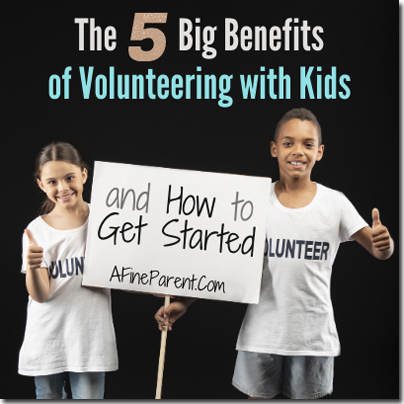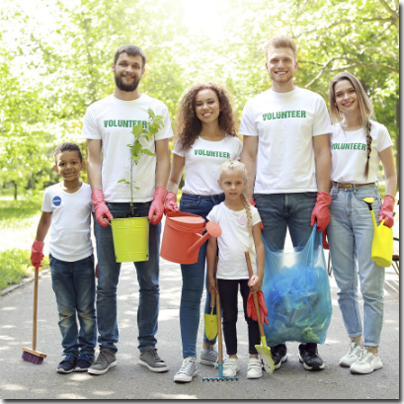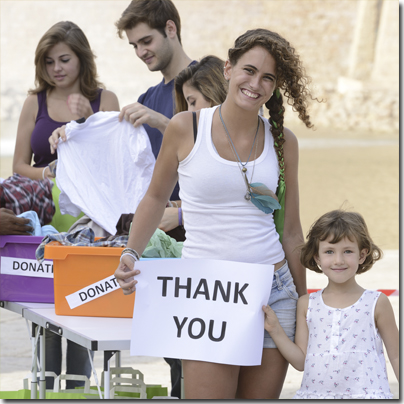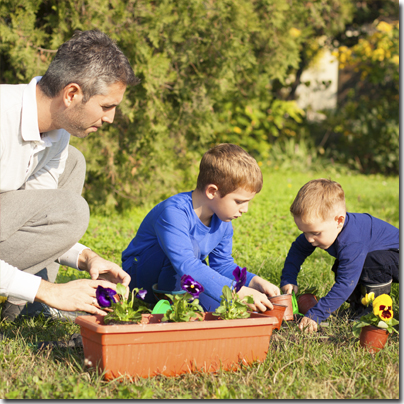 I scanned the mess in our living room…and couldn’t help but smile.
I scanned the mess in our living room…and couldn’t help but smile.
Two kids sat at one end of a card table. One child flopped turkey slices on bread while the other added cheese. A third child was loading baby carrots into sandwich bags at the other end of the table, while the toddler did what she did best: cheerfully pull things out of place and generally add to the chaos.
Then the assembly process began. As the stacks of food dwindled, the other card table for finished sack lunches grew.
The kids were proud as they cleaned up the mess and surveyed their donation.
We took the sack lunches to the shelter as a family. The kids smiled and waved at the people milling around the shelter. Although they were from a completely different walk of life, it didn’t seem to matter to our kids or the people who stopped to chat.
As we drove home that afternoon, everyone felt really good.
I wish I could say every experience volunteering with kids was like this.
In reality, it’s not.
If volunteering with kids seems hard to you, you’re not alone.
Sometimes it’s hard to make time and the whole event feels stressful. Other times, kids argue through the whole process, complain, or can’t seem to think of anyone but themselves.
Hey, as a parent, sometimes I’m the one to blame too.
Volunteering with kids is not always easy, but it is worth it.
Benefits of Volunteering With Kids
When we make it a priority to volunteer as a family, we provide benefits to our entire family unit; and of course, we’re helping others in the community as well.
The benefits of volunteering in general are well-researched and vast. Here are a few that apply to our children.
1. Volunteering Builds Beneficial Skill Sets for Later in Life
 As our kids volunteer, they practice various skills depending on what service they are providing.
As our kids volunteer, they practice various skills depending on what service they are providing.
A child who volunteers at a food pantry might learn valuable organizational skills. A child who donates gently used items learns to give of self and declutter.
Overarching principles of empathy, working hard, and problem solving are intricately woven into the process of volunteerism.
Volunteering is a meaningful way to practice skills in real-world situations.
2. Volunteering Increases Self-Efficacy and Self-Esteem

Research shows that individuals who volunteer report higher levels of both self-efficacy and self-esteem.
But why is that a benefit for our kids?
Psychologist Albert Bandura explains,
“Perceived self-efficacy refers to beliefs in one’s capabilities to organize and execute the courses of action required to manage prospective situations.”
In other words, self-efficacy is believing we can do what needs to be done in order to handle a situation. It’s a big cause of motivation and it influences how we think and act.
Bandura further explains that the most powerful way to increase self-efficacy is through “mastery experiences.” When we experience success, we believe we’ll have success in future situations as well.
So, it makes sense that when our children have experiences where their volunteer actions help solve a problem, they’ll feel more confident in their ability to make a positive difference in the future.
Self-esteem also increases with volunteerism, helping our kids feel better about their self-worth or personal value.
I see this very simply when I explain to my four-year-old that we appreciate her help with household chores and that she is an important part of our family team. She smiles, feels good about herself, and is happy to participate.
Volunteering helps our kids feel good about themselves and their ability to contribute. This improves their current well-being and motivates them to continually participate in similar activities, creating a beneficial cycle of feeling confident, doing good, and feeling good.
3. Volunteering Increases Gratitude
When we volunteer, it often opens our children’s eyes to experiences that are less fortunate than their own. Even as adults, we sometimes don’t realize what we could be grateful for; however, when we meet people at a shelter who don’t have a home or send packages to military personnel stationed overseas, it helps us learn not to take things for granted.
Vast amounts of research has linked gratitude with an increased sense of well-being and happiness. We can follow-up volunteer experiences with conversation and gratitude practices that have the potential to change our children’s brains and lives for the better.
4. Volunteering Strengthens Connections
 When I saw my kids interacting with the individuals at the shelter and watched the smiles cross the faces of the adults they helped, I was reminded of the importance of human connection.
When I saw my kids interacting with the individuals at the shelter and watched the smiles cross the faces of the adults they helped, I was reminded of the importance of human connection.
In fact, one of the longest studies on human health and happiness has found that the number one predictor of both health and happiness is not genes or job satisfaction. Robert Waldinger, one of the directors of the study, said, “The clearest message that we get from this 75-year study is this: Good relationships keep us happier and healthier. Period.”
Volunteering provides a powerful way for our kids to connect with others and helps them learn prosocial habits for the future. When we serve, we strengthen our relationship with those we serve and those we serve with.
As positive parents, connection is at the heart of all we do. Volunteering can be a meaningful part of that connection.
5. Volunteering Increases Happiness
 From all the benefits mentioned already, it’s probably not a surprise that one of the general consequences of volunteering is increased well-being and happiness.
From all the benefits mentioned already, it’s probably not a surprise that one of the general consequences of volunteering is increased well-being and happiness.
A large, long study conducted between 1996 and 2014 tried to answer the question of whether it’s happy people who volunteer or if volunteering causes happiness. Because the study covered such a long period of time, they were able to see the effects for those who began volunteering as well as the cumulative effects of volunteering.
This study, along with many others, found that individuals who volunteered reported a greater sense of well-being. However, you don’t need studies to show you this. Just think about how you felt the last time you made a positive impact in the life of someone who needed it.
We can help our children have happier lives by volunteering with them.
How to Get Started Volunteering with Kids
All of these benefits are a great motivation for us to volunteer with our kids… but how do we begin? And how do we maximize the experience as a positive one and minimize the chance that it will go south?
Here are some tips for getting started with volunteering with kids and helping it go as positively as possible.
#1: Model Volunteering
 We teach very effectively by example. So whether it’s with the PTA, a religious organization, or another cause that’s important to you, find ways to include volunteerism in your own life.
We teach very effectively by example. So whether it’s with the PTA, a religious organization, or another cause that’s important to you, find ways to include volunteerism in your own life.
#2: Talk About Volunteering
We often hear the adage, “Action speaks louder than words.” However, at least when it comes to giving, actions and words speak loudest.
One study looked at the rates at which adolescents ages 12-18 volunteered. The study showed that if a parent volunteered, their child was 27% more likely to also volunteer. Additionally, if the parent volunteered and talked to their child about volunteering, the adolescent was 47% more likely to volunteer.
These conversations can be simple. We can explain why we choose to volunteer, how we have been impacted when others served us, or ask our kids what they see as the benefits of volunteerism.
#3: Brainstorm What We Can Give
 As a family, we can brainstorm what we have to offer right now. It could be money or time. Maybe we have a garden full of fresh vegetables or flowers in our yard. It is helpful to think about the unique talents of each family member or particular skill sets.
As a family, we can brainstorm what we have to offer right now. It could be money or time. Maybe we have a garden full of fresh vegetables or flowers in our yard. It is helpful to think about the unique talents of each family member or particular skill sets.
Does our child have a lot of energy that could be used for good, like raking a neighbor’s leaves? Maybe our child is particularly adept at communicating with others or sharing love and would be a blessing to elderly individuals in a care center. Perhaps their musical or artistic talents could be used in volunteer work.
Kids are more apt to get on board with service when we play to their strengths.
#4: Find Causes to Serve
It is a good idea to make a list of possible volunteer opportunities for our family.
We may want to consider causes that are personally meaningful for us. For example, a good friend lost a family member to breast cancer, so now as a family they support other families battling cancer.
If you’re not sure how to get involved with a cause, simply google, “Volunteer to help _______ .”
Here are a few resources that often have volunteer options that kids can do:
- Just Serve (lists local volunteer opportunities in many areas)
- Together We Rise (benefits children in foster care)
- Project Linus (helps get homemade blankets to kids in need through hospitals, first responders, or others)
- Operation Gratitude (organizes ways to support military families, first responders, and others)
While it can be wonderful to take advantage of organized chances to serve collectively with others, we also want to think about local and informal opportunities to volunteer, such as in our neighborhood, a nearby nursing home, or school community.
The opportunities for volunteering are truly endless!
#5: Schedule a Specific Volunteer Experience
 In choosing a volunteer opportunity, we want to schedule one that is aligned with what we can give as a family and who we want to serve.
In choosing a volunteer opportunity, we want to schedule one that is aligned with what we can give as a family and who we want to serve.
It is equally important to involve the kids with this step.
Research (and life experience!) shows that we’re more motivated when we feel some autonomy or choice in the matter. So within options that work for us, we can give our kids the choice.
For example, we can pick three opportunities that as the parent we think would be a good fit; and then let our kids choose between those. We can also give a choice about when we do the service.
For families that are just getting started, begin with a small commitment or a project that can be split up over shorter periods of time. It can be difficult to find big chunks of time for volunteering.
Once it is scheduled, we can put our chosen volunteer opportunity on the calendar.
Our lives are full, so if we don’t schedule volunteering, it’s probably not going to happen.
#6: Keep Enthusiasm and Realistic Expectations
 When it’s time to actually volunteer, go for it with enthusiasm! Our kids often take their mood cues from us. If we approach the experience with excitement and non-perfectionist expectations of doing good for others, our kids will more often do the same.
When it’s time to actually volunteer, go for it with enthusiasm! Our kids often take their mood cues from us. If we approach the experience with excitement and non-perfectionist expectations of doing good for others, our kids will more often do the same.
Hold onto reality. If setbacks or difficulties arise, remember that’s part of the journey. A new family endeavor usually takes practice.
Move forward with grace and go back to where we started. Remember all the benefits for our kids and those we serve.
We might also be pleasantly surprised with how well it actually goes when we volunteer with kids. It’s no secret that our children have big hearts. So often when we give them the framework or opportunity to serve, they jump all in.
Our kids feel the joy in giving meaningfully and we too may find ourselves surveying the experience and smiling.
The 2-Minute Action Plan for Fine Parents
As you embark on your volunteer experience, take some time to consider the following questions:
- Which benefits of volunteering would be especially helpful for my child?
- What kind of volunteerism am I currently modeling?
- What kind of volunteer opportunities or conversations have we had with our kids in the past?
- Do I feel drawn to support a specific cause right now?
- What can our family give?
The Ongoing Action Plan for Fine Parents
As you move toward becoming a volunteering family, use these reminders to keep you on track:
- Schedule and hold a meeting with your family and/or partner to start brainstorming what your family can give and what causes are important to you.
- Keep a running list of volunteer opportunities.
- As children develop talents, continue to encourage them to use their talents for good.
- In various ways, help your kids develop empathy and emotional intelligence which will open their eyes to future volunteer opportunities.
- After participating in volunteer work with your kids, reflect on how they felt, what went well, and what you could learn for future experiences.
- Develop a plan to regularly volunteer as a family.
Leave a Reply